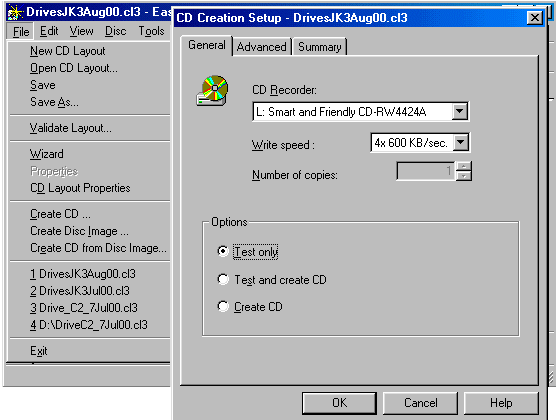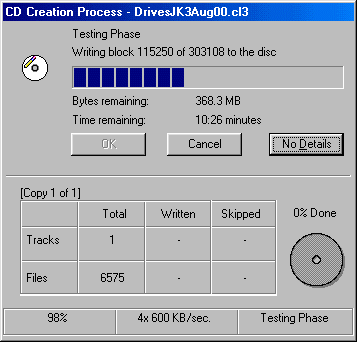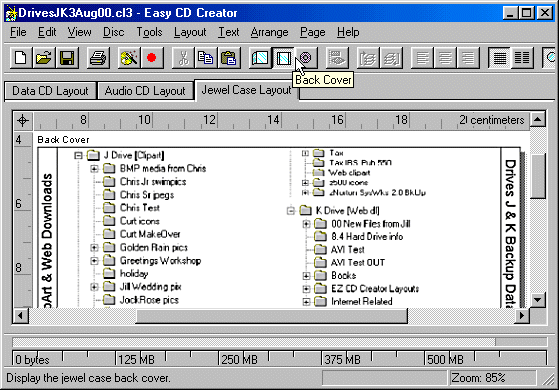|
This is part 2 of 2 on "Making a Data CD". Last
month in part 1 we went through creating a CD Layout with Adaptec's
Easy CD Creator (http://www.adaptec.com/products/overview/ecdc.html)
and all of the setup steps. This month we are going to go through
the actual CD creation (or burning) process.
Place a blank CD-R media disc into the CD-Recorder. Using
the CD Layout we created last time, go to the top left and select
"Create CD..." from the File dropdown menu. (Note,
do not select "Create CD from Disc Image..." as we
are creating a CD from a layout and not from a disc image.) A
"CD Creation Setup" box should pop up. First look at
the Advanced tab. Here we make sure "Close Session and Leave
Disc Open" is selected. This gives us the capability to
add additional data to the disc at a later time. We can do this
until the disc is full.
Next look at the Summary tab. This tab is informational and
basically verifies what we are about to do. It shows we are creating
a Data disc, the number of tracks, number of blocks of user data
to be recorded, temporary space required, that we want to preserve
normal file order, we are using the Joliet file system type,
long file names, etc.

Finally, look at the General tab. Here is listed the name
of the CD-Recorder we are using and the Write speed we will be
using. This is the place where the Write speed can be changed
to something slower if there is a concern about buffer underruns
due to the writing of complex data files. One can find out if
this is a concern by first doing a test run prior to creating
the CD. We do this by going to the lower portion of this tab
and under Options selecting "Test only" or "Test
and create CD" rather than "Create CD". I prefer
"Test only" as that gives me the option to change anything
I want after the Testing phase without going immediately into
the Recording phase. If buffer levels look low during the Testing
phase I might want to lower the Write speed as a precaution even
though I passed the Testing phase. If I make any changes I might
want to redo the Testing phase to see the effect of those changes.
When I am happy with the Testing phase I can then select the
"Create CD" radio button to record on to the CD. Depending
upon which option you have selected, clicking the OK button will
either start the Testing or Recording process.
The Testing phase is identical to the actual Recording (or
burning) phase except that the laser is not turned on so your
media disc in the CD-Recorder remains blank. This is the best
way to avoid making coasters. If for some reason the data is
not being read fast enough due to complexities in the data, i.e.
many, many small files or file directories many levels deep,
the test run will have a buffer underrun. The program will give
you an error report at the end of the test run. During the Testing
 phase,
click on the Details button to see what is actually happening
with the buffer level. I have seen my buffer level do a temporary
drop to 14% and still create a successful CD. If I see many drops
to low levels then I change to a lower Write speed before creating
the CD. Ideally if the program says you have created a successful
CD at the end of the Testing phase than there should be no problems
during the Recording phase. phase,
click on the Details button to see what is actually happening
with the buffer level. I have seen my buffer level do a temporary
drop to 14% and still create a successful CD. If I see many drops
to low levels then I change to a lower Write speed before creating
the CD. Ideally if the program says you have created a successful
CD at the end of the Testing phase than there should be no problems
during the Recording phase.
The downside of going through the Testing phase is the time
involved. Since the Testing phase is identical to the Recording
phase except for the laser not being turned on, the time for
doing the Testing phase is the same as for the Recording. If
you use a Write speed of 4x (600 kbytes/sec), that is approximately
19 minutes. At 2x speed the time doubles to 37 minutes. And of
course at 1x speed it would be 74 minutes. (These times do not
take into account several minutes for "reading the files"
and "preparing to write" nor the time for "writing
the Table of Contents".) It becomes a question of how valuable
is your time. If you take a chance and skip the Testing phase,
you could end up with a coaster. Then, to insure you don't make
another coaster, you would probably spend time doing the Testing
phase anyway.
If everything goes well Easy CD Creator ends the recording
process by writing the TOC or Table of Contents to the disc.
This can take up to two minutes. The important thing is not to
get impatient even if the program looks like nothing is happening.
(Clicking the Cancel button at anytime during the Recording phase
is a sure way to create a coaster.) After the TOC is written
Easy CD Creator pops open the CD-Recorder tray and tells you
that you have successfully created a CD.
I had no problems creating data backup CDs for all of my drives
except in one area, the C:\Windows directory. I had anticipated
this might be a problem area and so had dedicated a whole CD-R
disc to just the Windows directory. It turned out to be less
of a problem than I thought as only three files refused to copy.
Trying to get them to copy caused me to make my only coaster.
The three files giving me grief were all named the same, "index.dat".
They were in C:\Windows\Cookies, C:\Windows\Temporary Internet
Files\Content.IE5, and C:\Windows\History\History.IE5. Eliminating
the index.dat files alone, however, did not solve the problem.
I had to eliminate the folders (and all other files within) that
contained these dat files. Since they all seemed related to Internet
content saved by Internet Explorer 5 I did not consider this
any big loss. I might mention that prior to setting up to create
a data CD I had gone through IE5 and told it to delete all Temporary
Internet Files. Apparently it does not delete all one thinks
it is deleting. In fairness, I had saved several Internet sites
within IE5 for reading off line. I don't know for sure but this
may have been the reason these files were not deleted and thus
caused me grief.
One of the best features of Easy CD Creator is its capability
to create CD Jewel Case inserts for the CDs you have created.
Again there is no handy instruction sheet to tell you exactly
how to use this feature so you sort of have to experiment. It
works similar to other graphics type programs like Paint Shop
Pro (http://www.jasc.com/product.asp?pf_id=001)
and The Print Shop (http://www.mattelinteractive.com/store/Product.asp?OID=4142757&SC=0120056015).
Using it you can insert text of any font, change its size and
color, add a color fill in back of the text, and rotate the text
to 90 or 270 degrees for the Jewel Case edge or end panels (spines).
You can also change the background color for the whole insert,
add graphics from outside sources and layer graphics and text.
A feature I use for Data CDs is inserting a Data Snapshot of
what is on the CD. Essentially Easy CD Creator takes a picture
of whatever you have displayed in its lower left window pane
in the Data Layout tab. This is the Explorer type layout of what
is on the CD that you created. You can vary the size of the data
displayed and subsequently the snapshot by moving the layout's
horizontal bar separating the upper and lower panes. You can
open specific folders to display their contents for the snapshot
by clicking on the plus sign in front of the folder. I like to
display these tree type layouts on the Back Cover insert for
the Jewel Case.

I have found there is enough room to display two snapshots
side by side. On the Data CD Layout tab screen I can grab the
top piece of the data tree by setting the vertical scroll bar
slider in the layout's lower left pane to its top position. Next
I go to the Jewel Case Layout tab screen (where I already have
the blank Back Cover insert displayed), and select "Insert"
and "Data Snapshot" from the Edit dropdown menu. This
will paste the top piece of the data tree on to the screen where
it can then be positioned on the left side of the Back Cover.
Going back to the Data Layout tab, I then reposition the vertical
scroll bar slider to its bottom position in order to grab the
bottom piece of the data tree for pasting. Following the same
procedure it can then be positioned to the right of the top piece
data tree snapshot on the Back Cover. If a data snapshot exceeds
the Back Cover vertical size you can resize it by grabbing a
corner handle and pulling it inward at an angle, just like resizing
a photo in other graphic programs.
In addition to the Back Cover insert, Easy CD Creator allows
for making the Front Cover Jewel Case insert and the Disc Label.
For data CDs I just make the Back Cover insert which includes
the end panels (spines) so I can read the CD title when it is
standing on edge in a CD holder. Note that you do have to remove
the black plastic piece (that the CD rests in) from the clear
plastic Jewel Case outer shell in order to insert the Back Cover.
The two plastic pieces are a snap fit and I use a knife blade
along the top and bottom edges to separate them. For Audio CDs
I make both the Front and Back Cover inserts. I have not tried
making a Disc Label. There are commercial Disc Label kits available
that come with pre-cut adhesive backed CD label sheets and a
special tool (applicator) for properly centering the label. Some
of the companies that have CD Label kits available are
Surething (http://www.surething.com/),
Hewlett-Packard (http://www.cd-labeler.com/),
Neato (http://www.neato.com/
), and Memorex (http://www.memorex.com/products/label/bdy_label.html).
Now that you are armed with all this knowledge go out there
and burn those CDs!
Note: Web Master Wanderings
articles contain links to external web sites. Web addresses are
constantly changing. There is no guarantee that the information
links provided in this article will remain unbroken or up-to-date
beyond the date that this article is originally published. |